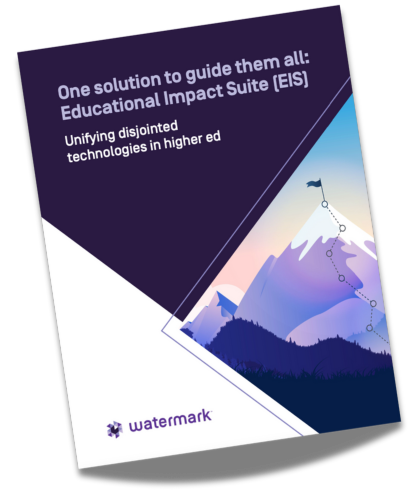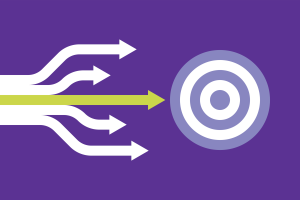Technological advancements have historically been slow to penetrate higher education. But as the evolution of edtech has boomed in recent years, these forces are now conjoined — for better and for worse. In 2020, higher education institutions were put to the ultimate test. Forced to adjust to the needs of a global crisis, colleges and universities had to execute remote learning at a scale and speed that some had never attempted. In an industry wary of leaving tradition behind, this put many in touch with a newfound sense of urgency to adapt. Unfortunately, that urgency meant that some institutions lacked long-term vision in their implementations. Their software solutions were scattered — and now so are they.


Higher ed has inevitably been altered by the technologies it has integrated, bringing new opportunities and new obstacles. Many institutions made great gains in the classroom with learning technologies. However, many of them also stopped short of updating legacy processes behind the scenes. They’ve locked up institutional knowledge in binders, static Excel sheets, and stacks of paper, leaving themselves hamstrung in the areas of self-study and assessment, accreditation and reaffirmation, and the collection of student feedback.
Other institutions have attempted to modernize these methods, but have become unfocused in their approach. Longtime tech innovator Alex Leader, Chief Impact Officer of Watermark, identifies one of higher ed institutions’ fundamental issues as “digital sprawl, where over time they’ve purchased solutions that solve one particular pain point without solving the overarching challenges that exist.” This creates a big identity problem and hampers scalability and control.

Colleges and universities that allow software solutions too much power in shaping their business procedures risk fragmenting their missions. Without a unified solution that enables them to make sense of where they are as they are, an organization will lack a strong sense of direction.
“There are vendor offerings that force an institution to operate a certain way, how the vendor thinks they should operate,” cautions Leader. “That removes the uniqueness and the flavor of the institution. It makes them, for lack of a better term, a factory.” Such an institution may find itself bleeding resources into the adoption and feeding of technologies that are disconnected from one another and that fail to offer actionable data.
“There are vendor offerings that force an institution to operate a certain way, how the vendor thinks they should operate. That removes the uniqueness and the flavor of the institution. It makes them, for lack of a better term, a factory.”
— Alex Leader, Chief Impact Officer, Watermark
An institution’s learning management system (LMS) and student information system (SIS), for example, primarily function as operational and delivery tools. There may be no way for them to meaningfully translate information or provide the kinds of big-picture insights that inspire progress.
Higher education requires something that can only be achieved with a new kind of centralizing system capable of driving critical action in leadership, student success, and continuous improvement. Its ability to accomplish all of this simultaneously relies on one marketplace innovation, says Leader — the Educational Impact Suite (EIS).
 “Institutional effectiveness and student success have traditionally been separate disciplines,” Leader points out. “But I really believe they’re one and the same. A high- performing institution will be creating programs that align with outcomes in the labor market, and then making sure that as students progress down these program paths, they’re supported along the way.” This all must include the integration and maintenance of processes essential to an institution’s strategic plan and data-driven growth initiatives.
“Institutional effectiveness and student success have traditionally been separate disciplines,” Leader points out. “But I really believe they’re one and the same. A high- performing institution will be creating programs that align with outcomes in the labor market, and then making sure that as students progress down these program paths, they’re supported along the way.” This all must include the integration and maintenance of processes essential to an institution’s strategic plan and data-driven growth initiatives.
In the aftermath of an immensely transitional time, many institutions are facing the question of whether they will continue to adapt or instead fall back on tradition. Yet the current market demands participation in a rapid rate of change. Institutions that want to remain competitive can only operate at this level of efficiency by defining their processes and finding software that supports these processes comprehensively.
This is the groundbreaking role of an Educational Impact Suite (EIS) in higher education institutions. As an integrated suite of tools, it is able to unify this work of organizational leadership, student success, and continuous improvement unlike any singular solution that exists.

When empowered to share these insights across separate disciplines, institutions are able to drive positive outcomes not only for their own organizational effectiveness, but also for the students they support and the communities they serve. This is the core of the EIS offering: educational impact.
What is educational impact? Amid declining enrollment and skyrocketing skepticism about the value of higher education, leaders are wise to be asking themselves this question. Ultimately, educational impact is measured in the growth of students, and the ways that growth reaches out to take root in an institution and a community. But what are the metrics of that growth — and how can institutions interpret them?
One crucial piece of creating educational impact is storytelling. Colleges and universities today are tasked with telling their stories to students, faculty, external stakeholders, and funding agencies. “The process of gathering data to tell that story is incredibly complex,” says Glenn Allen Phillips, Ph.D., Senior Insights Consultant at Watermark and former Director of Assessment at Howard University.
“The EIS is an efficient answer to the question of institutional storytelling. It assists in creating the data points that institutions need to tell those stories better.”
— Glenn Allen Phillips, Ph.D., Sr. Insights Consultant, Watermark
 Successful institutional storytelling requires that leaders have an easy way to understand progress, success, and improvement at their institutions. Rather than having to rely on anecdotal or reactive updates from deans and department heads, leaders should be able to proactively drive engagement, enact change, and share results regularly with stakeholders by accessing real-time project insights. Importantly, they need the capability to deliver this information just in time to understand the influence of their initiatives.
Successful institutional storytelling requires that leaders have an easy way to understand progress, success, and improvement at their institutions. Rather than having to rely on anecdotal or reactive updates from deans and department heads, leaders should be able to proactively drive engagement, enact change, and share results regularly with stakeholders by accessing real-time project insights. Importantly, they need the capability to deliver this information just in time to understand the influence of their initiatives.
What an EIS provides is “an efficient answer to the question of institutional storytelling,” says Dr. Phillips. It “assists in creating the data points that institutions need to tell those stories better.”
Having the tools to understand and control the narrative that lives in the data is especially important for historically underfunded institutions and schools that serve in disenfranchised communities. Being able to properly analyze and frame data in the context of an institution’s larger mission is critical not only to its relationship with those it serves but also to its continued accreditation.
“A lot of this is about creating a world where faculty feel part of institutional success and aligned with the mission. Solving the user experience is going to lessen that faculty dissonance and increase their engagement.”
— Monica Joy Krol, Director of Product, Watermark
Faculty buy-in is imperative to any institution’s achievements — and an EIS ensures a level of accessibility that accomplishes this with minimal pushback. Through EIS insights, faculty will become equipped to understand advances at their institution in a way that fuels their involvement. They’ll benefit from a consolidated user experience that connects modules while providing a “guided” narrative that simplifies workflows.
Faculty, tasked as they are with shaping the minds of the next generation, are understandably less focused on their roles as part of an institution’s business model. “A lot of this is about creating a world where they feel part of that process — part of institutional success and aligned with the mission,” says Monica Joy Krol, Director of Product at Watermark and former Director of Institutional Research and Assessment at Corning Community College. “Solving the user experience is going to lessen that faculty dissonance and increase their engagement.”
As an EIS provides consistency, guiding faculty to align and engage effectively with students and with their institution’s greater mission, it will also create in them a deepened sense of confidence using similar tools in the future.
Watermark supports over 1,700 higher ed institutions around the world with tools for accreditation management, assessment activities, faculty activity reporting, course evaluations and surveys, curriculum and catalog management, and student success and retention. Our innovative Educational Impact Suite thoughtfully connects these solutions so that they work as one to deliver the kinds of insights we’ve been helping institutions uncover over the last two decades — now with unparalleled efficiency, precision, and comprehensiveness.
Together, the suite helps institutions maximize their impact through improved performance, educational quality, student equity, and direct support of the student as they progress on their educational journey. Watermark is quickly releasing new connections in both data and experience that help everyone across an institution engage. A user-friendly solution that streamlines and digitizes essential processes, our EIS provides one hub that integrates all of your data so that you can see it in context.
Knowing that you’re on the right path forward requires the right insights. As institutions continue to grapple with their post-pandemic identities, they must embrace this opportunity to double down on their evolution. By digitizing and consolidating their processes in an EIS that doesn’t just revolutionize their procedures but also helps them gain deep institutional knowledge, colleges and universities guarantee that they will improve continuously — today and in the future. If they don’t, they risk losing students to the institutions that will.

See how our tools are helping clients right now, get in-depth information on topics that matter, and stay up-to-date on trends in higher ed.